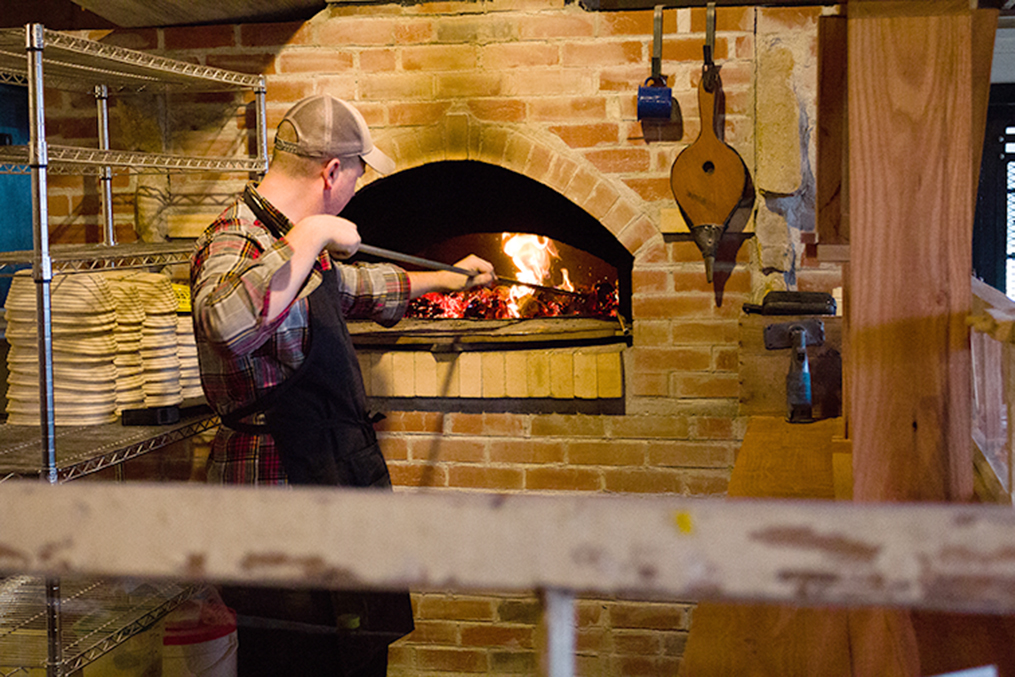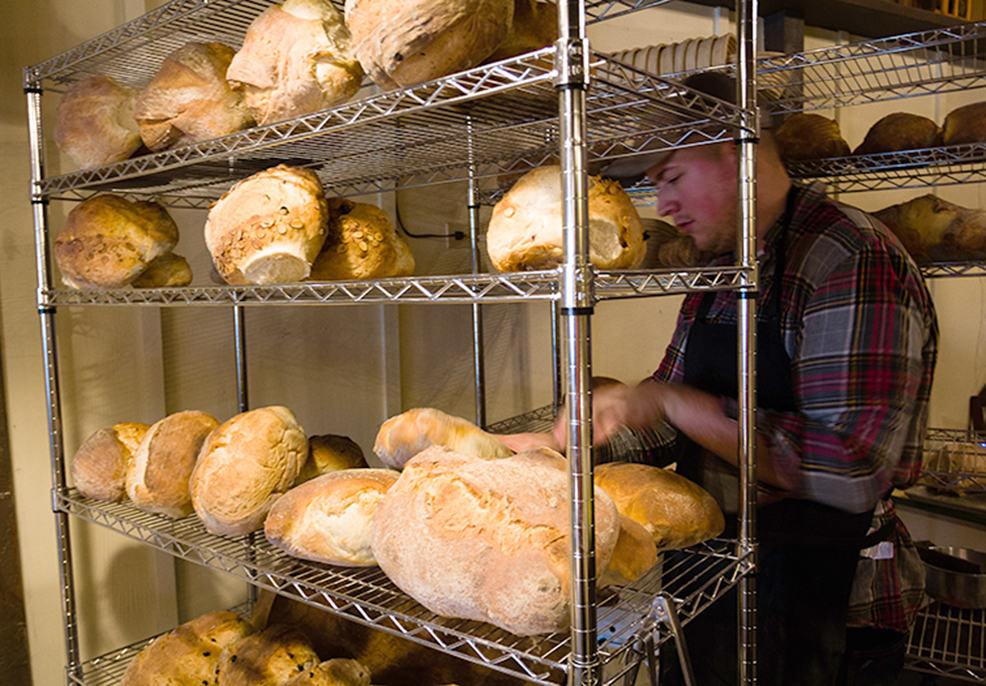 WESTON, Mo. — A 1979 Chevrolet Silverado slows and turns out of the chill darkness of Highway 45 at 4:20 A.M. A baker’s day begins early.
WESTON, Mo. — A 1979 Chevrolet Silverado slows and turns out of the chill darkness of Highway 45 at 4:20 A.M. A baker’s day begins early.
Shining across the parking lot, more cold clay than gravel, the headlights of the truck reveal the blue-gray repainted exterior of a retired apple barn. Inside, Dylan Low turns on dim bulbous tungsten lights revealing the building’s conversion into the only wood-fired bread baking oven in Missouri.
Low, 21, owns, operates and bakes for Hearth Bread Company in Weston.
Low grew up under the big sky of Wichita, Kan. When the spreading suburbs began to encroach upon the family, they moved here to Platte County, a place where they had vacationed, attracted by its small town tranquility.
The residual 350-degree Fahrenheit heat from yesterday’s baking has dried out the split maple and oak logs waiting over night like impatient crossed arms. Placing a rolled sheet of baking paper into the brick oven, Low ignites the fire with a propane torch.
Now it’s time for a cup of coffee.
“Most modern ovens have a timers on them where you don’t even have to get out of bed to turn it on,” Low explains. “To me, that kind of takes out the fun of what bakers do, you know, waking up early and all that good stuff.”
Low built the brick oven — an impressive feat for someone whose masonry resume stops at tuck-pointing brick houses with his father. A portion of Low’s design comes from Alan Scott, an Australian with a personal mission to keep brick oven baking from descending into an obscure footnote in gastronomy. A serendipitous find of a book about brick baking ovens at a second hand store, full of diagrams and descriptions, gave Low insights in the specifications for airflow.
Low describes the brick oven as a giant battery, soaking up the heat produced by the fire in its belly and slowly releasing it over a period hours. Clay fire bricks lining the interior of the oven have the heat absorption capacity of 15 to 20 feet of concrete.
The rustic outside of the oven is building grade brick and mortar.
Near the back door, split cedar, oak and maple wood wait in rough stacks. Cedar burns hot and fast. Oak burns slow and long. Some of the logs raised above the floor on pallets come from a tree that once resided in Low’s yard.
Selecting the right combination of wood is the equivalent of dialing the correct temperature on a modern oven.
“I kinda like splitting wood,” Low explained over his coffee mug. “I like fire because I’m a teenage boy, basically. And I like baking, so that all ties everything together.”
Low is a graduate of The Culinary Institute of America, earning an associate’s degree in baking and pastry arts.
“When you’re in school, you’re kind of expected not to be different. You’re there to learn the core fundamentals of what we do,” Low said.
A student in class decided to put coconut on her cake while in class. “I like coconut,” Low thought, so he followed suit.
Five minutes later the teacher chastised them, “You don’t have creative freedom here.”
Low guesses only 20 percent of his customers come from Weston. He should know; he makes it a priority to converse with each of them.
There is no menu out front. And no prices in the case. This forces conversation and allows Low to greet many of his customers by name when they return.
“I think it’s just a nice experience,” he said. “Then they’re not looking at a price tag on the menu, trying to decide which one is cheaper and which one they should get.”
The rest of his customer base make a dedicated trip to Hearth from other cities or route their errands to pass through Weston, population 1,700.
Many of Low’s repeat customers are from Leavenworth, Kan., home of Fort Leavenworth and a sizable population of military service members who have lived in Europe, some of whom brought back European spouses.
For those who want to celebrate the holiday season with a bit of Old World flavor, Low will make traditional European breads: Italian panettone, which takes several days to prepare; British and Irish hot cross buns, the spicy interior to remind of the spices used at the burial of Jesus and a paste cross to signify the crucifixion; German stollen, a bread with dried fruit, citrus and nuts.
These will be the first Christmas breads for Hearth Bread Company, which opened earlier this year.
From the refrigerator, Low hefts a tub of cranberry-orange muffin batter he made last night. The organic cranberries are from Maine, the winter citrus oranges from California.
Making batters and non-yeast doughs the night before baking lightens the work load in the morning.
Chilled patience also gives delicious chemistry time to slowly deepen and spread flavors and textures. For the holiday season, these three-ice-cream-scoop cranberry-orange muffins bake in festive red and white paper cups in the back kitchen convection oven.
Every morning Low walks into the bakery viewing it as a customer to see if he sees what he is looking for.
“I could have very easily got into a lease and a got a commercial gas oven and did all that. But then I wouldn’t be different,” he said. “I would be like any normal bakery.”
Basically, it’s not worth doing unless no one else is doing it.
Checking on the brick oven, Low stands at the oven door with an infrared thermometer to confirm his decision on the amount and kind of wood turning into glowing red coals. With a metal rake, he spreads the coals evenly over the oven floor to distribute the heat.
Always experimenting with new items to offer his customers, Low whacks a thawing rectangle of dough with the tapered end of French rolling pin. He is making sugar cookies for children that come with parents to Hearth.
Low leaves and returns to the warm kitchen testing the inch-thick rectangle of sugar cookie dough several times with a muscle-flexing application of the wood rolling pin. He waits until it is the perfect temperature to apply corporal discipline to coerce it thinner.
Gently worn copper and tin cookie cutters from the Low family collection cut the thinned dough into Christmas trees. The holiday items only add to what is already a thriving business.
“I like locally owned stores, even in different communities,” said Toni Ortiz, a customer from Parkville, Mo., holding a paper wrapped loaf of ciabatta, a scone and a grilled cheese sandwich on this day.
Back at the brick oven door, Low checks the temperature of the dark interior several times before he commits to making dough. He must intersect the rising fermentation of the bread with evening and cooling temperature of the oven. 530 degrees Fahrenheit is the desired cooking temperature for today’s ciabatta bread.
It’s time to start working with the dough.
Dylan pours a tub of flour into the mixing bowl of a Hobart. The bowl is big enough to swallow a home baker’s Kitchen-aid. The Hobart has no touch screen, no auto timer, no preset dials to hold a witty conversation with a baker.
Hobart is taciturn; on, off and speeds one, two and three. The all metal construction bruiser is still flexing its stirring power with a menacing hook since the 1970s.
Slap, slap, pop, slap.
The dough, properly mixed, submits to the rough treatment of Hobart. Slap, slap, pop, slap. Air pockets in the dough burst loudly on impact with the sides of the metal mixing bowl like a boxer tossed to the side of the ring by an opponent from a heavier weight class.
The yeast filled dough pushes at the top of the plastic bin. Low tests the dough, poking it, pulling it, stretching it. Satisfied, it is time to divide it into loaves.
After generous tosses of flour, Low lays out the dough on a wooden countertop. More flour. He kneads it thinner and longer, all the while looking like a masseuse loosening shoulders and a chiropractor straightening a spine.
More flour.
From the great mass, low cuts loaves roughly measured by hand and eye. More flour. From the uniformity of the mass comes the beginning of the individuality, the character, the features of each loaf.
More flour.
Where factory bread has the advantage of uniformity, exactitude, symmetry, this handmade bread has style. Factory bread has a label to help the customer know which brand or type to choose. Customers at Hearth choose more than type, ciabatta, they choose a look. “That one. No. One shelf up. Yes that one.”
Tim Riley from St. Joseph, Mo. made time to stop at Hearth while out on errands. Adjusting his paper wrapped lemon scone, and gruyere and ham scone he said, “It’s all homemade and stuff that you normally don’t find other places.”
The loaves settle in baskets imported from Bavaria, Germany. The wicker shape of the basket makes minimal contact with the dough allowing it to fall out of the basket with minimal sticking onto a wide wood paddle.
Low feeds the long handle of the paddle into the dark oven. A flashlight at the door is the only guiding light. With practiced dexterity, he tips the paddle slightly downward.
With the gentle speed of an athletic clean and jerk, Low removes the paddle empty; six loves in place at once.
After a double-check with the infrared thermometer, Low positions the sheet metal and wood oven door. The residual heat of the fire bricks on the oven floor and intense heat of the air trapped inside work chemical magic, an alchemy of bread aficionados, to bake the bread evenly and create a colorful crust as ancient as the art of brick oven baking.
The paddle works in reverse to extract the loaves.
Low inspects and places each loaf on a cooling rack in plain sight of customers. Witnessing the baker at work in this rustic setting is as much of an attraction for customers as their own confirmation of the bread’s value in taste.
Ready for sale, Low pushes the stainless steel rack on wheels from behind the counter he made from reclaimed wood and window panes past the fading turquoise blue 1950s Crosly Shelvedor refrigerator keeping drinks cool. The wheels glide over the smooth cement of the barn, paint lines for dividing apple piles still visible, past a 13-star American flag, to wait for customers behind an antique display case.
The curves of the dark wood and less than transparent glass of the display case is evidence it was made in an era before square corners became fashionably efficient and cheap. The tungsten lighting inside the case invites a food adventure: try a lemon scone. There is only one left.
“Usually, we use this bread as gifts,” said Maj. Jason Martinez, who lives in Weston. He walks out with two ciabattas under his arm.
Michaela Fraundorfer, store front worker, waitress and cashier, wraps each order, warm ciabatta bread to ham and Gruyere scones, in brown paper. She ties each package closed with baker’s twine, a staple of craft stores for making new objects look old with instant nostalgia, a visual reference to a time when, well, bakers made bread in a brick oven.





